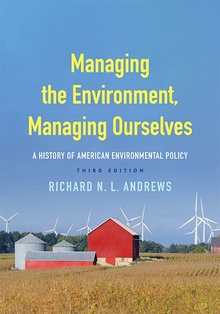Environmental Policy
Richard N. L. Andrews—
Environmental protection policy includes three elements intended to protect public health and ecological processes from adverse effects of human activities. One is pollution control, including prevention, safe management, and cleanup of waste discharges, accidental spills, and deliberate environmental dispersion of toxic materials such as pesticides. The second is sustainable natural resource management—a broader concept of “conservation”—including maintenance of naturally renewable resources (groundwater, forests, fish and wildlife, arable soils), regulation of rates of extraction and use of nonrenewable resources (water, fuels, strategic minerals), and management of conflicting uses of landscapes for commodity production and recreation. The third is preservation of natural and cultural heritage, including areas of special beauty, historical and cultural significance, ecological functions, and landscape character.
Environmental policy as a whole, however, includes all government actions that promote the alteration of natural environmental conditions and processes, for whatever purpose and under whatever label. Policies promoting mineral extraction, agriculture or forestry or outdoor recreation, urban or industrial development, or transportation infrastructure are just as much elements of environmental policy as are pollution control regulations or habitat protection programs, whether or not they are called by that name. So are military operations, international trade agreements, and other policies that have significant environmental impacts.
This broad definition has important practical implications. First, the “real” environmental policy of a government is not necessarily what its officials say it is, nor what the statutes and regulations say, but what government actually does to the natural environment. Many official statements represent only what a public official wishes environmental policy to be, or what he or she wishes the public to believe it is, rather than what is actually happening. Even policies enacted as laws often are undercut by conflicting mandates or underfunded budgets, and others are ineffective in achieving their stated purposes.
Second, many of the most powerful instruments of environmental policy are lodged not in environmental protection agencies but in agencies that transform environmental conditions for other purposes. The policies of the Agriculture, Defense, Energy, Interior, and Transportation Departments, for instance, affect the environment at least as much as those of the Environmental Protection Agency (EPA), and their budgets are far larger. Some of the most effective policy strategies for protecting the environment, therefore, might not necessarily involve adding new EPA regulations, but changing or eliminating environmentally damaging incentives administered by other departments. Many such incentives—such as agricultural subsidies, below-cost logging and mining concessions, and underpriced use of water, fuels, and grazing lands—have been criticized for economic reasons as well. More generally, the best way to achieve an environmental policy goal might often be to improve coordination of conflicting policies across multiple agencies, rather than add a new mandate to one agency.
From Managing the Environment, Managing Ourselves by Richard N. L. Andrews. Published by Yale University Press in 2020. Reproduced with permission.
Richard N. L. Andrews is professor emeritus of environmental policy at the University of North Carolina at Chapel Hill. He has written, taught, and advised on U.S. environmental policy for fifty years and has served on multiple national environmental policy committees.
Further Reading:



























